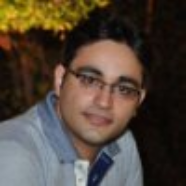PZT-on-silicon RF-mems lamb wave resonators and filters
Promotion date: December 13.
Promotor: Prof.dr.ir. Miko Elwenspoek
Assistant Promotor: Dr.ir. Niels Tas
| By increasing the number of wireless devices, the radio spectrum is quickly becoming overcrowded, asking for smart “cognitive radio” devices, which detect and exploit unused spectrum. This means that a radio system which can cover a wide frequency range from about 50MHz to 5 GHz is desirable. A key roadblock in this respect is the realization of a programmable RF pre-filter bank which contains several RF filters operating at different frequency bands. An RF filter bank requires miniaturization as the current filters (i.e. surface acoustic wave and film-bulk acoustic resonators) are big. It is not easy to integrate several of them together at different frequency bands. Lamb-wave piezoelectric RF-MEMS resonators and filters became a very interesting topic as their resonance frequency depends on the lateral dimensions of the electrodes. They are released from the substrate, providing a high Q-factor performance. Therefore, Lamb wave filters are the best candidate for replacing SAW and BAW filters. AlN, ZnO and recently PZT thin-films, are the prevalent piezoelectric materials utilized in resonators. Of these, PZT has the highest electromechanical coupling-factor which is a big opportunity to reduce the size of the filters and keep the motional impedance low. In this thesis we propose a feed-through cancellation method in the presence of a specific grounding resistances (non-zero grounding) at the input and output-sides, which always exists and prevents perfect grounding. Using the proposed technique, the stopband rejection of the resonator is improved by more than 20 dB. Conventional electromechanical filters are using mechanical and/or electrical couplings. However, this new technique is based on the phase change of two un-coupled resonators below and above their resonances. This technique resolves the design issue associated with the high feed-through at high frequencies as well as exploiting piezoelectric materials with high-dielectric constants, like PZT. |
Was your research application driven?
For sure this research was application driven, as the quest for filtering, in almost all wireless devices, is a worldwide research effort. Combining and integrating all filter functionalities onto one chip would be a great improvement in the miniaturization trends taking place now for decennia.
In this project I used vibrating MEMS devices for electronic application, i.e. bandpass filters. We used mechanical knowledge, on vibration effects, to design filter devices for high frequencies in the range of 50 MHz till approximately 1 GHz. For MESA+ this research domain was quite new, so in the beginning of my PhD project at the Transducers Science and Technology (TST) group, we had still to find our way, simply by learning a lot from a variety of attempts.
Two new ideas did arise from our work, of which the last one was also reported in the Dutch national newspaper NRC Handelsblad.
The first result involved the growing of piezoelectric material. This we were successful in by the special collaboration - we were lucky to find - with SolMateS, a spin-off company from the University of Twente. This collaboration was all the more special as the company did this out of curious reasons mainly, not demanding special economic rewards in return. The first experimental results, after about two years of research and experiments - really observing the phenomena we were eager to see - was an important step in this project, for me as for my supervisors. From there on we were able to improve our findings further.
The second innovation was the completely new way we found to utilize two un-coupled resonators, acting just below and above the center frequency of the filter. This led to a filtering behavior that was never seen before, resulting in a completely new bandpass filter concept and device.
Papers resulted from this in Applied Physics Letters, two times, and in the Journal of Micromechanics and Microengineering. Also I presented on the international MEMS conference 2014.
In what way did you develop as a scientist and researcher in the PhD period?
When I started, I had a good theoretical background but virtually no experimental experience. The TST group - my supervisors and also the technicians - were very helpful in guiding me on this track. I learned to systematically design and perform experiments.
I am very happy to be at the base of expertise built-up on this field. Also we developed new ideas for acoustic-microfluidics as continuation of PhD research. A lot of discussions were held with my colleagues, constructing new expertise for future research on this new field.
I will be a post-doc researcher at MESA+ for the year to come, and afterwards, I would like to continue working on acousto-microfludics. In this field I am not busy optimizing small devices. Instead I really pursue the creation of new opportunities, and make novel devices from there.
What in your opinion is important for MESA+ to stay successful as an institution in future?
MESA+ offers a great atmosphere and a unique structure of organization. The research is multidisciplinary in nature, as is the right way to proceed in future I believe. Also the entrepreneurial atmosphere I value greatly. One of the ideas of my research project is involved in a patent procedure now, which is very exciting.
The facilities are great, and I think MESA+ should keep on striving for these. Apparatus to produce graphene for example, and optical lithography with higher accuracy than we have access to now, can be of interest. The last is important in my field, as we have already reached the limitation of the current available system. To be able to develop further higher accuracy optical lithography machines, like wafer steppers lithography machines, are desirable.

